Comprehensive Analysis of Gender Pay Gap in UK Workplace
VerifiedAdded on 2023/01/04
|48
|11792
|56
Report
AI Summary
This report provides a comprehensive analysis of the gender pay gap in the UK, examining the reasons for wage disparities between men and women. The study begins with an introduction outlining the background, aims, and significance of the research, followed by a rationale for the study and its objectives and research questions. The report addresses the barriers and scope of the research, followed by an extensive literature review covering the concept of the gender wage gap, relevant theories (occupational segregation, gender role theory, and human capital theory), measurement, factors, and reasons for the gap. The methodology section details the research approach, design, strategy, methods, data sources, ethical considerations, and timeline. The findings are presented through primary data analysis (survey of 121 employees) and secondary data analysis (ONS data sets), with detailed analysis of the data collected. The report concludes with a summary of the findings, conclusions, and recommendations for addressing the gender pay gap and promoting gender equality in the workplace.

Running Head: BUSINESS
BUSINESS
BUSINESS
Paraphrase This Document
Need a fresh take? Get an instant paraphrase of this document with our AI Paraphraser
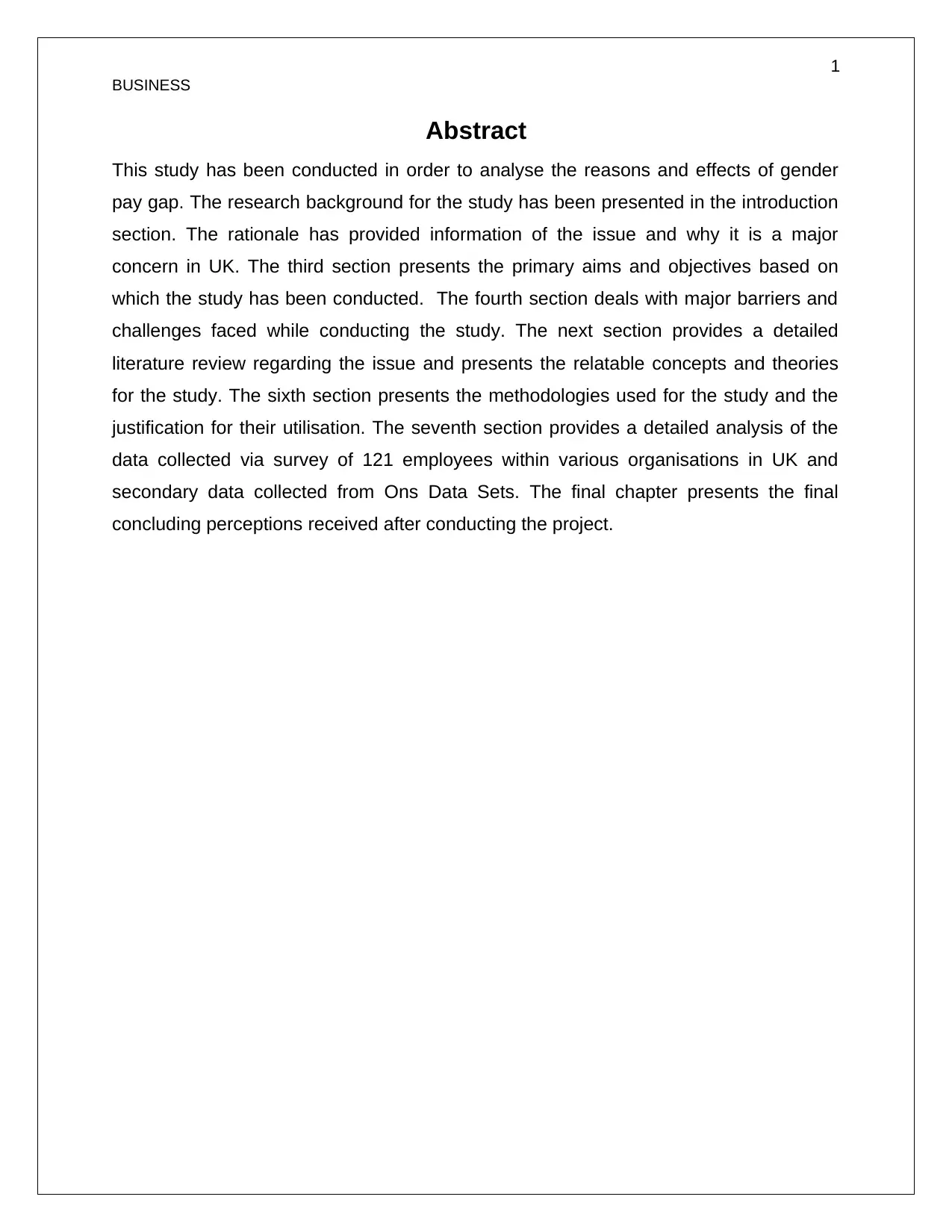
1
BUSINESS
Abstract
This study has been conducted in order to analyse the reasons and effects of gender
pay gap. The research background for the study has been presented in the introduction
section. The rationale has provided information of the issue and why it is a major
concern in UK. The third section presents the primary aims and objectives based on
which the study has been conducted. The fourth section deals with major barriers and
challenges faced while conducting the study. The next section provides a detailed
literature review regarding the issue and presents the relatable concepts and theories
for the study. The sixth section presents the methodologies used for the study and the
justification for their utilisation. The seventh section provides a detailed analysis of the
data collected via survey of 121 employees within various organisations in UK and
secondary data collected from Ons Data Sets. The final chapter presents the final
concluding perceptions received after conducting the project.
BUSINESS
Abstract
This study has been conducted in order to analyse the reasons and effects of gender
pay gap. The research background for the study has been presented in the introduction
section. The rationale has provided information of the issue and why it is a major
concern in UK. The third section presents the primary aims and objectives based on
which the study has been conducted. The fourth section deals with major barriers and
challenges faced while conducting the study. The next section provides a detailed
literature review regarding the issue and presents the relatable concepts and theories
for the study. The sixth section presents the methodologies used for the study and the
justification for their utilisation. The seventh section provides a detailed analysis of the
data collected via survey of 121 employees within various organisations in UK and
secondary data collected from Ons Data Sets. The final chapter presents the final
concluding perceptions received after conducting the project.
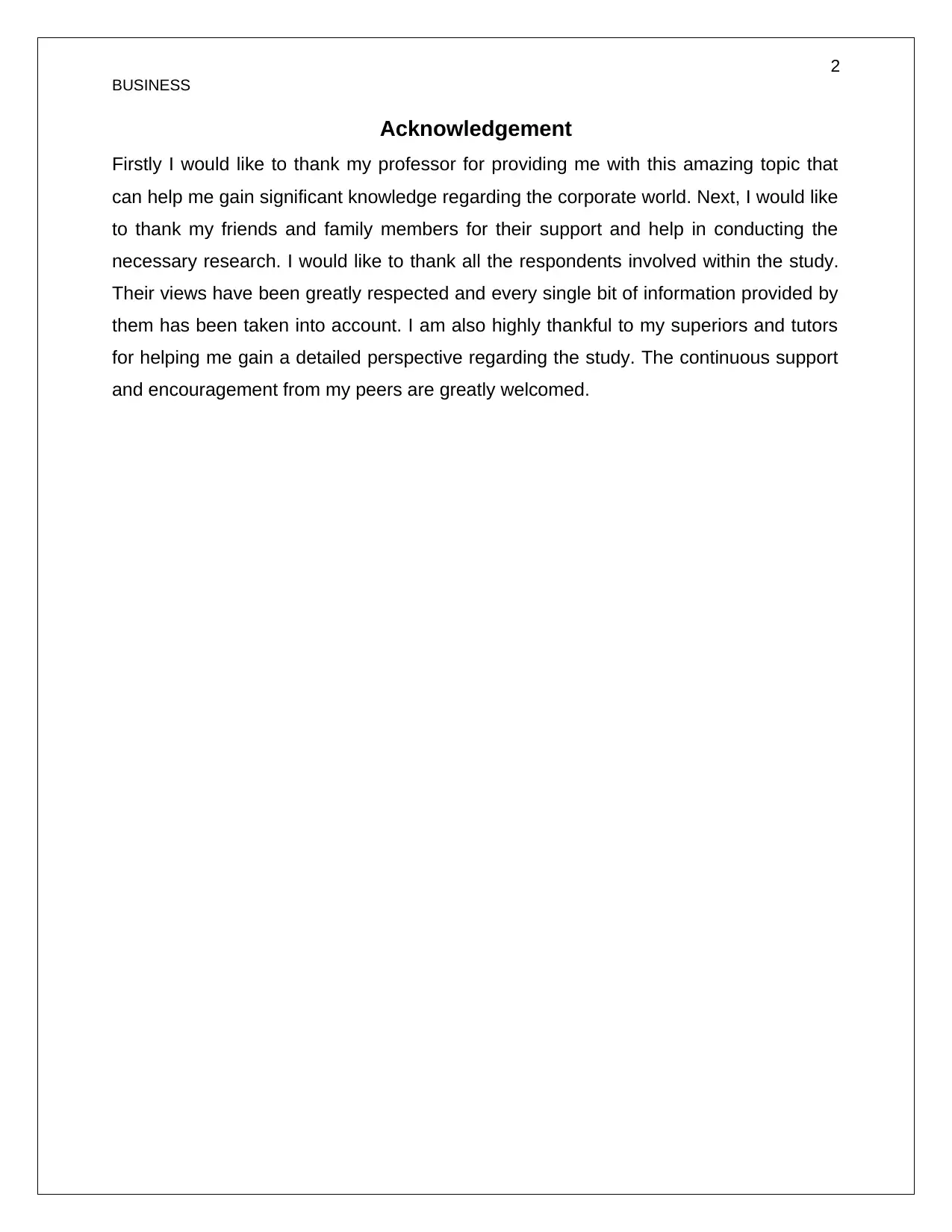
2
BUSINESS
Acknowledgement
Firstly I would like to thank my professor for providing me with this amazing topic that
can help me gain significant knowledge regarding the corporate world. Next, I would like
to thank my friends and family members for their support and help in conducting the
necessary research. I would like to thank all the respondents involved within the study.
Their views have been greatly respected and every single bit of information provided by
them has been taken into account. I am also highly thankful to my superiors and tutors
for helping me gain a detailed perspective regarding the study. The continuous support
and encouragement from my peers are greatly welcomed.
BUSINESS
Acknowledgement
Firstly I would like to thank my professor for providing me with this amazing topic that
can help me gain significant knowledge regarding the corporate world. Next, I would like
to thank my friends and family members for their support and help in conducting the
necessary research. I would like to thank all the respondents involved within the study.
Their views have been greatly respected and every single bit of information provided by
them has been taken into account. I am also highly thankful to my superiors and tutors
for helping me gain a detailed perspective regarding the study. The continuous support
and encouragement from my peers are greatly welcomed.
⊘ This is a preview!⊘
Do you want full access?
Subscribe today to unlock all pages.

Trusted by 1+ million students worldwide
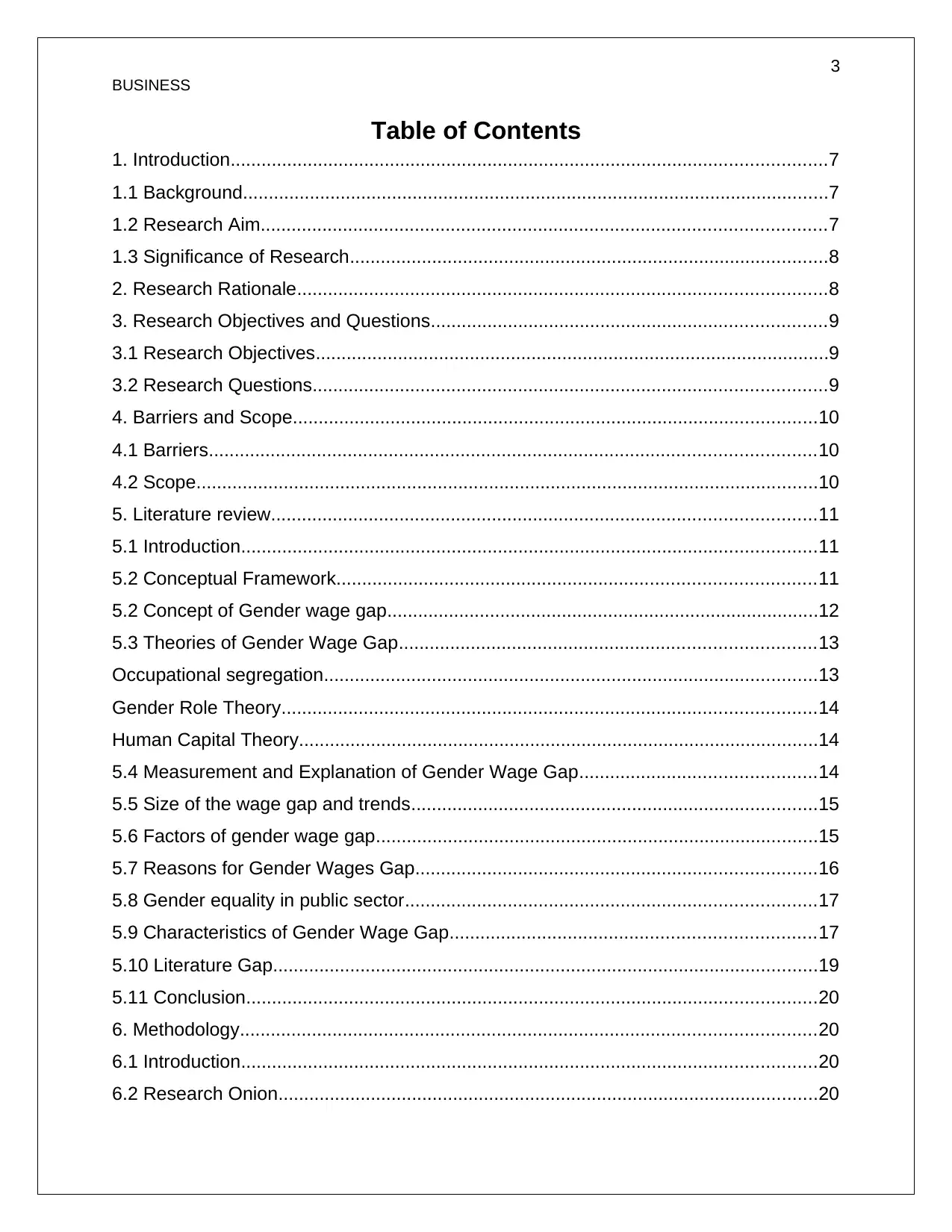
3
BUSINESS
Table of Contents
1. Introduction....................................................................................................................7
1.1 Background..................................................................................................................7
1.2 Research Aim..............................................................................................................7
1.3 Significance of Research.............................................................................................8
2. Research Rationale.......................................................................................................8
3. Research Objectives and Questions.............................................................................9
3.1 Research Objectives....................................................................................................9
3.2 Research Questions....................................................................................................9
4. Barriers and Scope......................................................................................................10
4.1 Barriers......................................................................................................................10
4.2 Scope.........................................................................................................................10
5. Literature review..........................................................................................................11
5.1 Introduction................................................................................................................11
5.2 Conceptual Framework.............................................................................................11
5.2 Concept of Gender wage gap....................................................................................12
5.3 Theories of Gender Wage Gap.................................................................................13
Occupational segregation................................................................................................13
Gender Role Theory........................................................................................................14
Human Capital Theory.....................................................................................................14
5.4 Measurement and Explanation of Gender Wage Gap..............................................14
5.5 Size of the wage gap and trends...............................................................................15
5.6 Factors of gender wage gap......................................................................................15
5.7 Reasons for Gender Wages Gap..............................................................................16
5.8 Gender equality in public sector................................................................................17
5.9 Characteristics of Gender Wage Gap.......................................................................17
5.10 Literature Gap..........................................................................................................19
5.11 Conclusion...............................................................................................................20
6. Methodology................................................................................................................20
6.1 Introduction................................................................................................................20
6.2 Research Onion.........................................................................................................20
BUSINESS
Table of Contents
1. Introduction....................................................................................................................7
1.1 Background..................................................................................................................7
1.2 Research Aim..............................................................................................................7
1.3 Significance of Research.............................................................................................8
2. Research Rationale.......................................................................................................8
3. Research Objectives and Questions.............................................................................9
3.1 Research Objectives....................................................................................................9
3.2 Research Questions....................................................................................................9
4. Barriers and Scope......................................................................................................10
4.1 Barriers......................................................................................................................10
4.2 Scope.........................................................................................................................10
5. Literature review..........................................................................................................11
5.1 Introduction................................................................................................................11
5.2 Conceptual Framework.............................................................................................11
5.2 Concept of Gender wage gap....................................................................................12
5.3 Theories of Gender Wage Gap.................................................................................13
Occupational segregation................................................................................................13
Gender Role Theory........................................................................................................14
Human Capital Theory.....................................................................................................14
5.4 Measurement and Explanation of Gender Wage Gap..............................................14
5.5 Size of the wage gap and trends...............................................................................15
5.6 Factors of gender wage gap......................................................................................15
5.7 Reasons for Gender Wages Gap..............................................................................16
5.8 Gender equality in public sector................................................................................17
5.9 Characteristics of Gender Wage Gap.......................................................................17
5.10 Literature Gap..........................................................................................................19
5.11 Conclusion...............................................................................................................20
6. Methodology................................................................................................................20
6.1 Introduction................................................................................................................20
6.2 Research Onion.........................................................................................................20
Paraphrase This Document
Need a fresh take? Get an instant paraphrase of this document with our AI Paraphraser

4
BUSINESS
6.4 Research approach...................................................................................................22
6.5 Research design........................................................................................................23
6.6 Research Strategy.....................................................................................................23
6.7 Methods and Tools....................................................................................................23
6.8 Data Sources.............................................................................................................24
6.9 Ethical Consideration.................................................................................................24
6.10 Timeline (Gantt chart)..............................................................................................24
7. Findings.......................................................................................................................25
7.1 Introduction................................................................................................................25
7.2 Primary Data Analysis...............................................................................................25
7.3 Secondary Data Analysis..........................................................................................35
7.3.1 Gender Pay Gap Timeline......................................................................................35
7.3.2 Gender Pay Gap and occupations.........................................................................36
7.4 Summary....................................................................................................................37
8. Conclusion and Recommendations.............................................................................37
8.1 Conclusion.................................................................................................................37
8.2 Recommendations.....................................................................................................38
Reference List..................................................................................................................39
Appendices......................................................................................................................47
BUSINESS
6.4 Research approach...................................................................................................22
6.5 Research design........................................................................................................23
6.6 Research Strategy.....................................................................................................23
6.7 Methods and Tools....................................................................................................23
6.8 Data Sources.............................................................................................................24
6.9 Ethical Consideration.................................................................................................24
6.10 Timeline (Gantt chart)..............................................................................................24
7. Findings.......................................................................................................................25
7.1 Introduction................................................................................................................25
7.2 Primary Data Analysis...............................................................................................25
7.3 Secondary Data Analysis..........................................................................................35
7.3.1 Gender Pay Gap Timeline......................................................................................35
7.3.2 Gender Pay Gap and occupations.........................................................................36
7.4 Summary....................................................................................................................37
8. Conclusion and Recommendations.............................................................................37
8.1 Conclusion.................................................................................................................37
8.2 Recommendations.....................................................................................................38
Reference List..................................................................................................................39
Appendices......................................................................................................................47
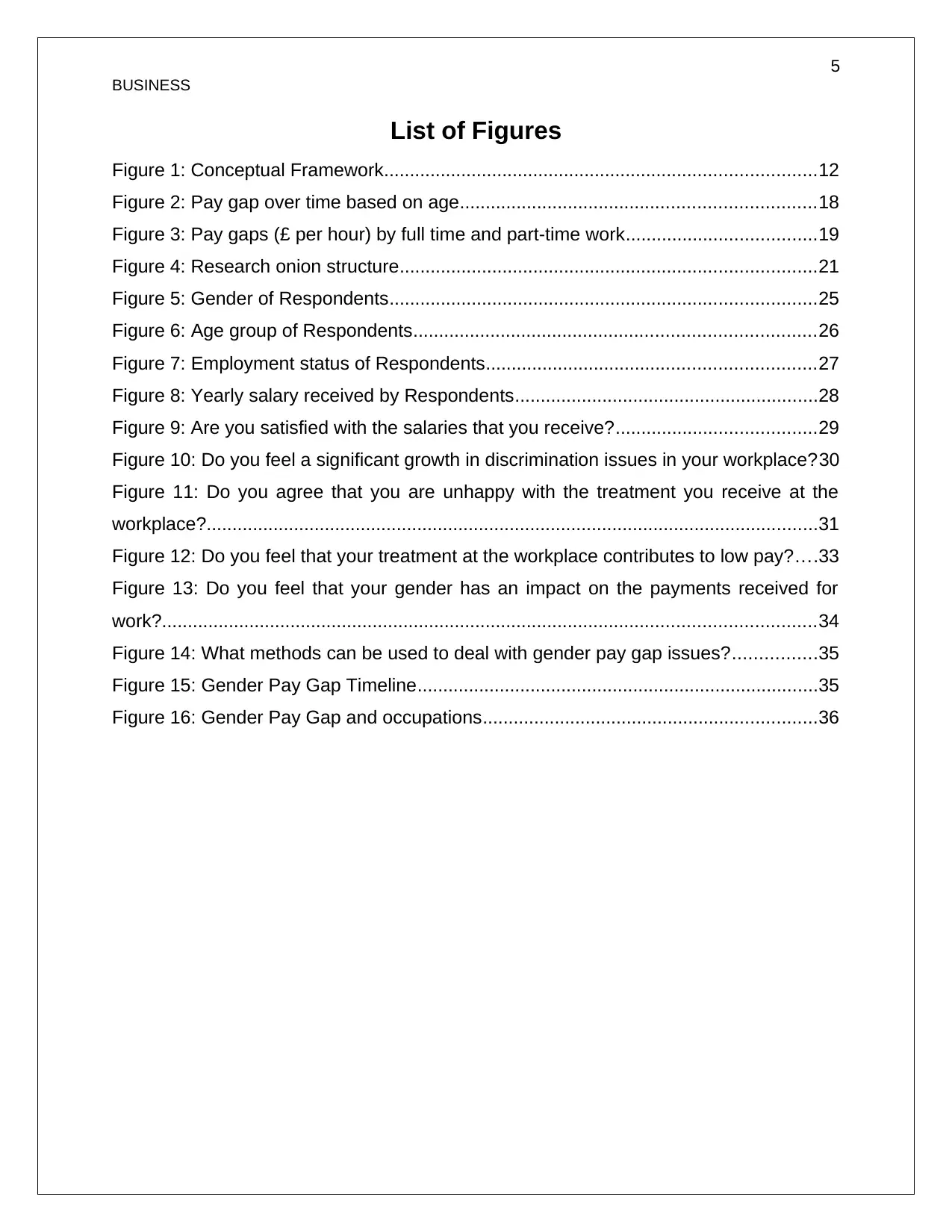
5
BUSINESS
List of Figures
Figure 1: Conceptual Framework....................................................................................12
Figure 2: Pay gap over time based on age.....................................................................18
Figure 3: Pay gaps (£ per hour) by full time and part-time work.....................................19
Figure 4: Research onion structure.................................................................................21
Figure 5: Gender of Respondents...................................................................................25
Figure 6: Age group of Respondents..............................................................................26
Figure 7: Employment status of Respondents................................................................27
Figure 8: Yearly salary received by Respondents...........................................................28
Figure 9: Are you satisfied with the salaries that you receive?.......................................29
Figure 10: Do you feel a significant growth in discrimination issues in your workplace?30
Figure 11: Do you agree that you are unhappy with the treatment you receive at the
workplace?.......................................................................................................................31
Figure 12: Do you feel that your treatment at the workplace contributes to low pay?....33
Figure 13: Do you feel that your gender has an impact on the payments received for
work?...............................................................................................................................34
Figure 14: What methods can be used to deal with gender pay gap issues?................35
Figure 15: Gender Pay Gap Timeline..............................................................................35
Figure 16: Gender Pay Gap and occupations.................................................................36
BUSINESS
List of Figures
Figure 1: Conceptual Framework....................................................................................12
Figure 2: Pay gap over time based on age.....................................................................18
Figure 3: Pay gaps (£ per hour) by full time and part-time work.....................................19
Figure 4: Research onion structure.................................................................................21
Figure 5: Gender of Respondents...................................................................................25
Figure 6: Age group of Respondents..............................................................................26
Figure 7: Employment status of Respondents................................................................27
Figure 8: Yearly salary received by Respondents...........................................................28
Figure 9: Are you satisfied with the salaries that you receive?.......................................29
Figure 10: Do you feel a significant growth in discrimination issues in your workplace?30
Figure 11: Do you agree that you are unhappy with the treatment you receive at the
workplace?.......................................................................................................................31
Figure 12: Do you feel that your treatment at the workplace contributes to low pay?....33
Figure 13: Do you feel that your gender has an impact on the payments received for
work?...............................................................................................................................34
Figure 14: What methods can be used to deal with gender pay gap issues?................35
Figure 15: Gender Pay Gap Timeline..............................................................................35
Figure 16: Gender Pay Gap and occupations.................................................................36
⊘ This is a preview!⊘
Do you want full access?
Subscribe today to unlock all pages.

Trusted by 1+ million students worldwide
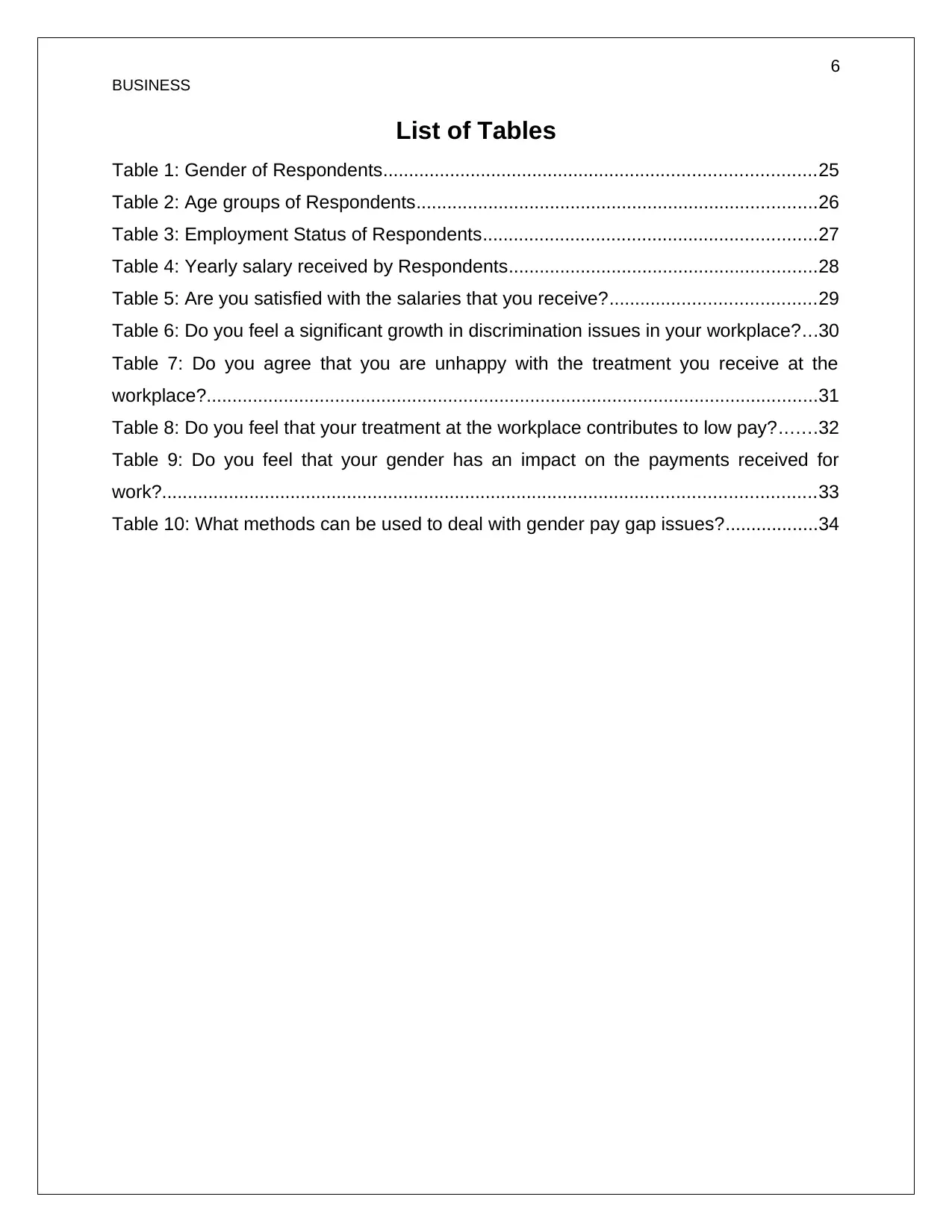
6
BUSINESS
List of Tables
Table 1: Gender of Respondents....................................................................................25
Table 2: Age groups of Respondents..............................................................................26
Table 3: Employment Status of Respondents.................................................................27
Table 4: Yearly salary received by Respondents............................................................28
Table 5: Are you satisfied with the salaries that you receive?........................................29
Table 6: Do you feel a significant growth in discrimination issues in your workplace?...30
Table 7: Do you agree that you are unhappy with the treatment you receive at the
workplace?.......................................................................................................................31
Table 8: Do you feel that your treatment at the workplace contributes to low pay?.......32
Table 9: Do you feel that your gender has an impact on the payments received for
work?...............................................................................................................................33
Table 10: What methods can be used to deal with gender pay gap issues?..................34
BUSINESS
List of Tables
Table 1: Gender of Respondents....................................................................................25
Table 2: Age groups of Respondents..............................................................................26
Table 3: Employment Status of Respondents.................................................................27
Table 4: Yearly salary received by Respondents............................................................28
Table 5: Are you satisfied with the salaries that you receive?........................................29
Table 6: Do you feel a significant growth in discrimination issues in your workplace?...30
Table 7: Do you agree that you are unhappy with the treatment you receive at the
workplace?.......................................................................................................................31
Table 8: Do you feel that your treatment at the workplace contributes to low pay?.......32
Table 9: Do you feel that your gender has an impact on the payments received for
work?...............................................................................................................................33
Table 10: What methods can be used to deal with gender pay gap issues?..................34
Paraphrase This Document
Need a fresh take? Get an instant paraphrase of this document with our AI Paraphraser

7
BUSINESS
1. Introduction
Gender Wage gap mainly refers the gap of paid remuneration between men and women
on the basis of work. It has caught the attention as many describes that women are
generally gets less payment than men at workplace with same working potential. The
variations between salary amounts vary with fundamental factors such as occupation
choice, skills, educational aspect and experience within the relevant sector. The
reasons behind lower payment also vary with working quality and personal preferences
for selective services. However, many scholars claim that wages gap has highly
affected with discrimination such as gender equality, race and disability. Wages gap
between employees may affect social quality and total economic out of the society.
1.1 Background
Gender pay equality within a sector-based workplace is highly influenced by several
thought process of the society and environment of the working background on the basis
of work potential of employees. Gender Wage gap is not a new concept in worldwide
working culture as the globalization of industrial concept involved women employees
more significantly in order to deliver more productive workforce within the development
of the sector (Hallward‐Driemeier, Rijkers & Waxman, 2017). However, the world
economic forum has claimed that gender wage gap is affecting the economic equality in
workplace and it is getting wider daily basis. This inequality between men and women
mainly based on the working hours, domestic and care responsibilities of women and
motherhood of the women. Is has been found that on average, women earn 77 cents for
every 1 dollar earned by men. Many economists say that gender pay inequality affects
the overall growth of GDP up to .9 percent. This contributes to increased issues with
conflicts in the workplace in regards to discrimination. Additionally, as stated by Heinz et
al (2016), gender pay inequality is hampering poverty rate and work force balance.
BUSINESS
1. Introduction
Gender Wage gap mainly refers the gap of paid remuneration between men and women
on the basis of work. It has caught the attention as many describes that women are
generally gets less payment than men at workplace with same working potential. The
variations between salary amounts vary with fundamental factors such as occupation
choice, skills, educational aspect and experience within the relevant sector. The
reasons behind lower payment also vary with working quality and personal preferences
for selective services. However, many scholars claim that wages gap has highly
affected with discrimination such as gender equality, race and disability. Wages gap
between employees may affect social quality and total economic out of the society.
1.1 Background
Gender pay equality within a sector-based workplace is highly influenced by several
thought process of the society and environment of the working background on the basis
of work potential of employees. Gender Wage gap is not a new concept in worldwide
working culture as the globalization of industrial concept involved women employees
more significantly in order to deliver more productive workforce within the development
of the sector (Hallward‐Driemeier, Rijkers & Waxman, 2017). However, the world
economic forum has claimed that gender wage gap is affecting the economic equality in
workplace and it is getting wider daily basis. This inequality between men and women
mainly based on the working hours, domestic and care responsibilities of women and
motherhood of the women. Is has been found that on average, women earn 77 cents for
every 1 dollar earned by men. Many economists say that gender pay inequality affects
the overall growth of GDP up to .9 percent. This contributes to increased issues with
conflicts in the workplace in regards to discrimination. Additionally, as stated by Heinz et
al (2016), gender pay inequality is hampering poverty rate and work force balance.
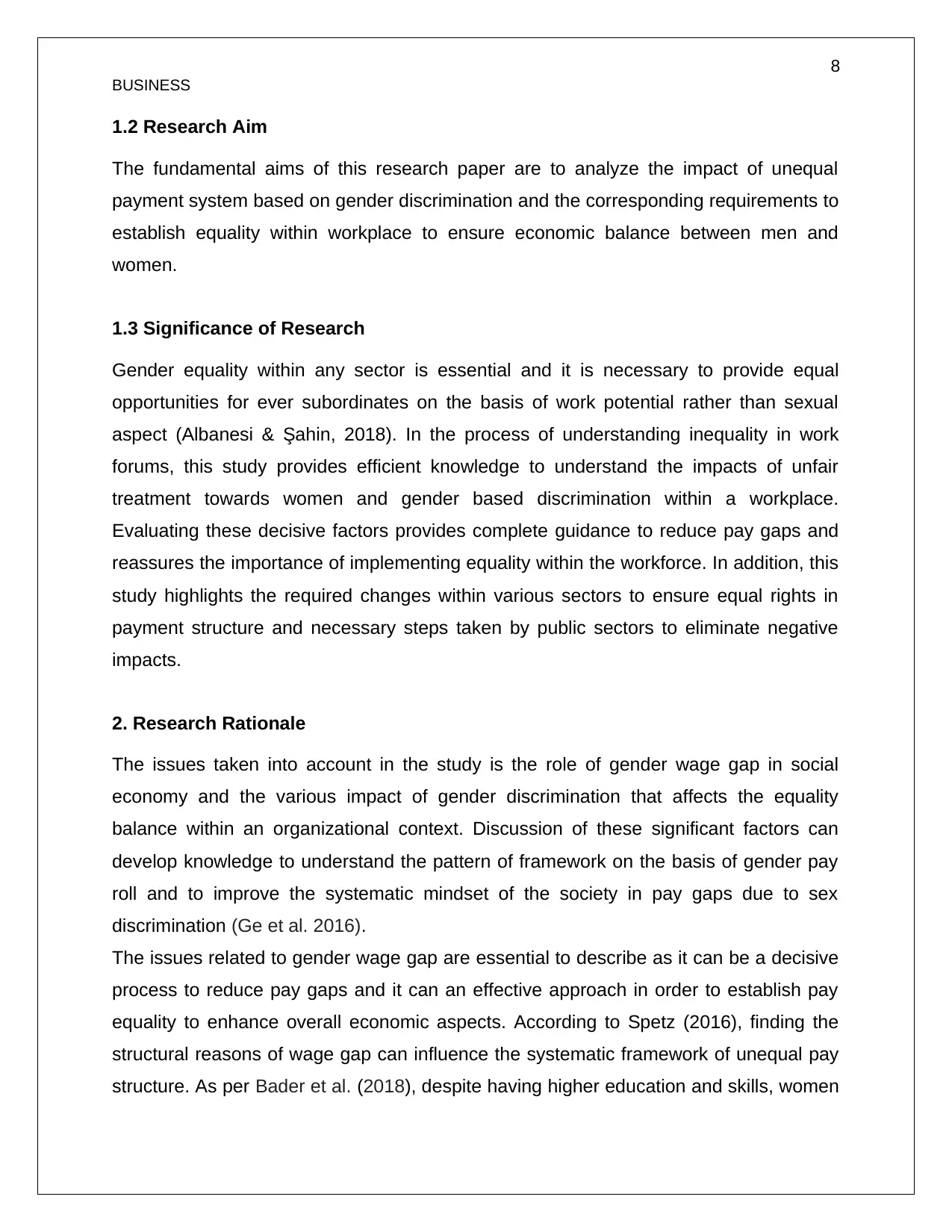
8
BUSINESS
1.2 Research Aim
The fundamental aims of this research paper are to analyze the impact of unequal
payment system based on gender discrimination and the corresponding requirements to
establish equality within workplace to ensure economic balance between men and
women.
1.3 Significance of Research
Gender equality within any sector is essential and it is necessary to provide equal
opportunities for ever subordinates on the basis of work potential rather than sexual
aspect (Albanesi & Şahin, 2018). In the process of understanding inequality in work
forums, this study provides efficient knowledge to understand the impacts of unfair
treatment towards women and gender based discrimination within a workplace.
Evaluating these decisive factors provides complete guidance to reduce pay gaps and
reassures the importance of implementing equality within the workforce. In addition, this
study highlights the required changes within various sectors to ensure equal rights in
payment structure and necessary steps taken by public sectors to eliminate negative
impacts.
2. Research Rationale
The issues taken into account in the study is the role of gender wage gap in social
economy and the various impact of gender discrimination that affects the equality
balance within an organizational context. Discussion of these significant factors can
develop knowledge to understand the pattern of framework on the basis of gender pay
roll and to improve the systematic mindset of the society in pay gaps due to sex
discrimination (Ge et al. 2016).
The issues related to gender wage gap are essential to describe as it can be a decisive
process to reduce pay gaps and it can an effective approach in order to establish pay
equality to enhance overall economic aspects. According to Spetz (2016), finding the
structural reasons of wage gap can influence the systematic framework of unequal pay
structure. As per Bader et al. (2018), despite having higher education and skills, women
BUSINESS
1.2 Research Aim
The fundamental aims of this research paper are to analyze the impact of unequal
payment system based on gender discrimination and the corresponding requirements to
establish equality within workplace to ensure economic balance between men and
women.
1.3 Significance of Research
Gender equality within any sector is essential and it is necessary to provide equal
opportunities for ever subordinates on the basis of work potential rather than sexual
aspect (Albanesi & Şahin, 2018). In the process of understanding inequality in work
forums, this study provides efficient knowledge to understand the impacts of unfair
treatment towards women and gender based discrimination within a workplace.
Evaluating these decisive factors provides complete guidance to reduce pay gaps and
reassures the importance of implementing equality within the workforce. In addition, this
study highlights the required changes within various sectors to ensure equal rights in
payment structure and necessary steps taken by public sectors to eliminate negative
impacts.
2. Research Rationale
The issues taken into account in the study is the role of gender wage gap in social
economy and the various impact of gender discrimination that affects the equality
balance within an organizational context. Discussion of these significant factors can
develop knowledge to understand the pattern of framework on the basis of gender pay
roll and to improve the systematic mindset of the society in pay gaps due to sex
discrimination (Ge et al. 2016).
The issues related to gender wage gap are essential to describe as it can be a decisive
process to reduce pay gaps and it can an effective approach in order to establish pay
equality to enhance overall economic aspects. According to Spetz (2016), finding the
structural reasons of wage gap can influence the systematic framework of unequal pay
structure. As per Bader et al. (2018), despite having higher education and skills, women
⊘ This is a preview!⊘
Do you want full access?
Subscribe today to unlock all pages.

Trusted by 1+ million students worldwide
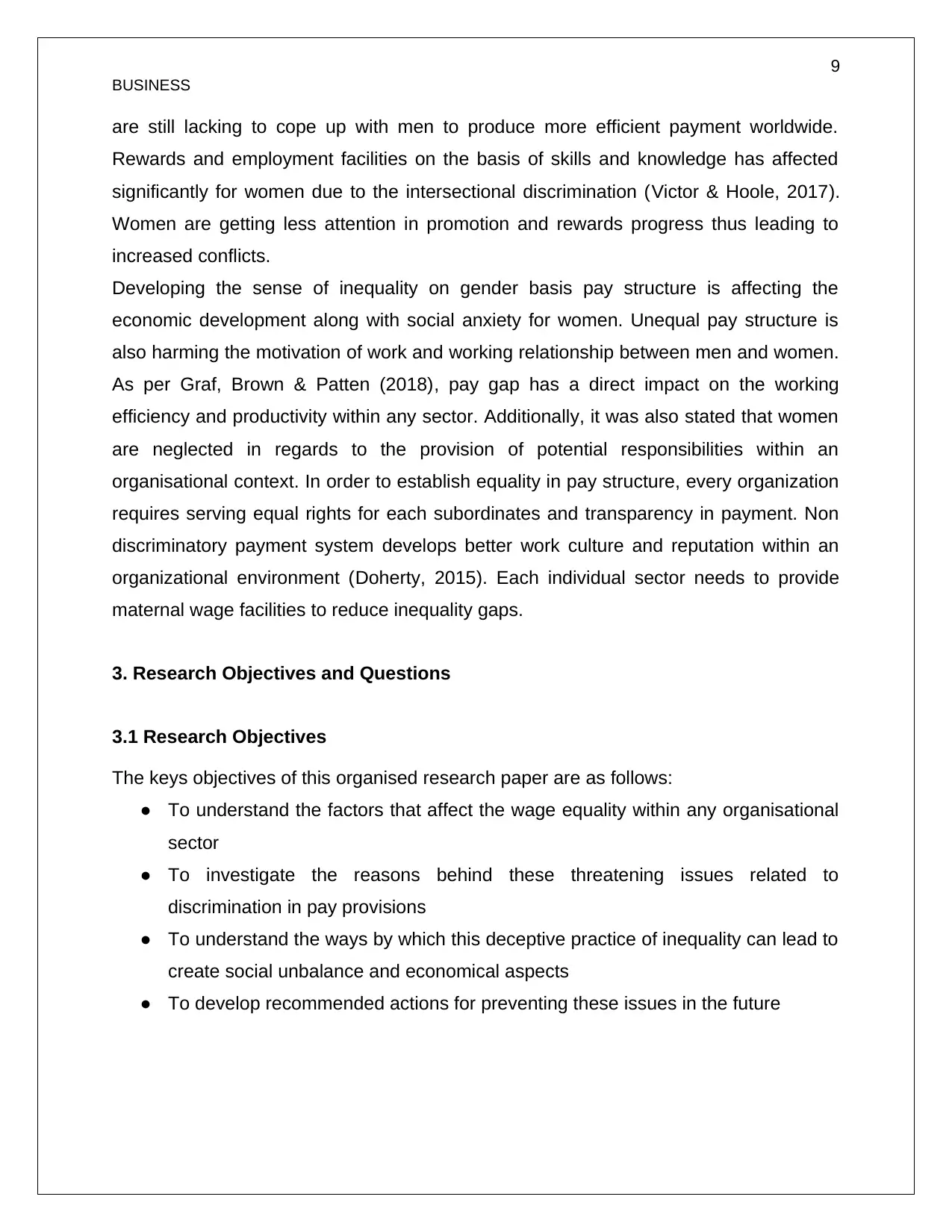
9
BUSINESS
are still lacking to cope up with men to produce more efficient payment worldwide.
Rewards and employment facilities on the basis of skills and knowledge has affected
significantly for women due to the intersectional discrimination (Victor & Hoole, 2017).
Women are getting less attention in promotion and rewards progress thus leading to
increased conflicts.
Developing the sense of inequality on gender basis pay structure is affecting the
economic development along with social anxiety for women. Unequal pay structure is
also harming the motivation of work and working relationship between men and women.
As per Graf, Brown & Patten (2018), pay gap has a direct impact on the working
efficiency and productivity within any sector. Additionally, it was also stated that women
are neglected in regards to the provision of potential responsibilities within an
organisational context. In order to establish equality in pay structure, every organization
requires serving equal rights for each subordinates and transparency in payment. Non
discriminatory payment system develops better work culture and reputation within an
organizational environment (Doherty, 2015). Each individual sector needs to provide
maternal wage facilities to reduce inequality gaps.
3. Research Objectives and Questions
3.1 Research Objectives
The keys objectives of this organised research paper are as follows:
● To understand the factors that affect the wage equality within any organisational
sector
● To investigate the reasons behind these threatening issues related to
discrimination in pay provisions
● To understand the ways by which this deceptive practice of inequality can lead to
create social unbalance and economical aspects
● To develop recommended actions for preventing these issues in the future
BUSINESS
are still lacking to cope up with men to produce more efficient payment worldwide.
Rewards and employment facilities on the basis of skills and knowledge has affected
significantly for women due to the intersectional discrimination (Victor & Hoole, 2017).
Women are getting less attention in promotion and rewards progress thus leading to
increased conflicts.
Developing the sense of inequality on gender basis pay structure is affecting the
economic development along with social anxiety for women. Unequal pay structure is
also harming the motivation of work and working relationship between men and women.
As per Graf, Brown & Patten (2018), pay gap has a direct impact on the working
efficiency and productivity within any sector. Additionally, it was also stated that women
are neglected in regards to the provision of potential responsibilities within an
organisational context. In order to establish equality in pay structure, every organization
requires serving equal rights for each subordinates and transparency in payment. Non
discriminatory payment system develops better work culture and reputation within an
organizational environment (Doherty, 2015). Each individual sector needs to provide
maternal wage facilities to reduce inequality gaps.
3. Research Objectives and Questions
3.1 Research Objectives
The keys objectives of this organised research paper are as follows:
● To understand the factors that affect the wage equality within any organisational
sector
● To investigate the reasons behind these threatening issues related to
discrimination in pay provisions
● To understand the ways by which this deceptive practice of inequality can lead to
create social unbalance and economical aspects
● To develop recommended actions for preventing these issues in the future
Paraphrase This Document
Need a fresh take? Get an instant paraphrase of this document with our AI Paraphraser

10
BUSINESS
3.2 Research Questions
This research question based on which the research paper has been delivered are as
follows:
● What are the factors affect the wage equality within any organisational sector?
● What are the reasons behind various issues relating to discrimination in pay
structures?
● How do these deceptive practices in inequality lead to create social unbalance
and economical aspects?
● What are the recommended actions that can be taken in order to deal with these
issues?
4. Barriers and Scope
4.1 Barriers
The prime barriers in conducting the study are as follows:
Sex based discrimination issues are highly popular in the modern world and a
large number of people have negative mindsets towards these factors (McCord
et al. 2018). Therefore, the study may face issues in regards to hostility and a
large number of biased views.
Most people involved in these issues relating to discrimination are not going to
present their views openly (McDonald & Charlesworth, 2016). Therefore, the
study can only deduce the reasons based on human psychology and cannot
present the exact or accurate factor.
4.2 Scope
The scope of the study is as follows:
The study will be able to provide information on the prime factors that influence
the provision of low wages.
BUSINESS
3.2 Research Questions
This research question based on which the research paper has been delivered are as
follows:
● What are the factors affect the wage equality within any organisational sector?
● What are the reasons behind various issues relating to discrimination in pay
structures?
● How do these deceptive practices in inequality lead to create social unbalance
and economical aspects?
● What are the recommended actions that can be taken in order to deal with these
issues?
4. Barriers and Scope
4.1 Barriers
The prime barriers in conducting the study are as follows:
Sex based discrimination issues are highly popular in the modern world and a
large number of people have negative mindsets towards these factors (McCord
et al. 2018). Therefore, the study may face issues in regards to hostility and a
large number of biased views.
Most people involved in these issues relating to discrimination are not going to
present their views openly (McDonald & Charlesworth, 2016). Therefore, the
study can only deduce the reasons based on human psychology and cannot
present the exact or accurate factor.
4.2 Scope
The scope of the study is as follows:
The study will be able to provide information on the prime factors that influence
the provision of low wages.
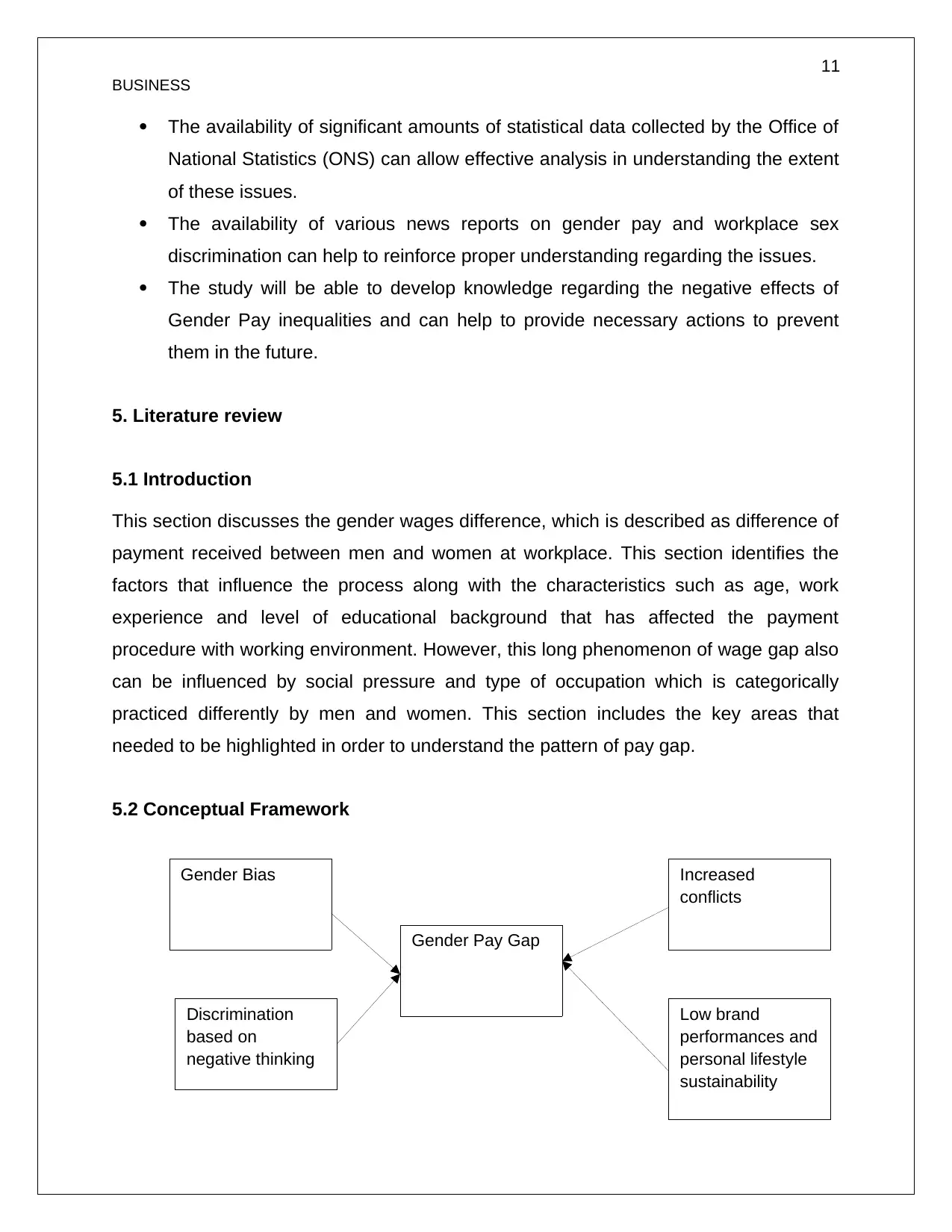
11
BUSINESS
The availability of significant amounts of statistical data collected by the Office of
National Statistics (ONS) can allow effective analysis in understanding the extent
of these issues.
The availability of various news reports on gender pay and workplace sex
discrimination can help to reinforce proper understanding regarding the issues.
The study will be able to develop knowledge regarding the negative effects of
Gender Pay inequalities and can help to provide necessary actions to prevent
them in the future.
5. Literature review
5.1 Introduction
This section discusses the gender wages difference, which is described as difference of
payment received between men and women at workplace. This section identifies the
factors that influence the process along with the characteristics such as age, work
experience and level of educational background that has affected the payment
procedure with working environment. However, this long phenomenon of wage gap also
can be influenced by social pressure and type of occupation which is categorically
practiced differently by men and women. This section includes the key areas that
needed to be highlighted in order to understand the pattern of pay gap.
5.2 Conceptual Framework
Discrimination
based on
negative thinking
Gender Bias
Gender Pay Gap
Low brand
performances and
personal lifestyle
sustainability
Increased
conflicts
BUSINESS
The availability of significant amounts of statistical data collected by the Office of
National Statistics (ONS) can allow effective analysis in understanding the extent
of these issues.
The availability of various news reports on gender pay and workplace sex
discrimination can help to reinforce proper understanding regarding the issues.
The study will be able to develop knowledge regarding the negative effects of
Gender Pay inequalities and can help to provide necessary actions to prevent
them in the future.
5. Literature review
5.1 Introduction
This section discusses the gender wages difference, which is described as difference of
payment received between men and women at workplace. This section identifies the
factors that influence the process along with the characteristics such as age, work
experience and level of educational background that has affected the payment
procedure with working environment. However, this long phenomenon of wage gap also
can be influenced by social pressure and type of occupation which is categorically
practiced differently by men and women. This section includes the key areas that
needed to be highlighted in order to understand the pattern of pay gap.
5.2 Conceptual Framework
Discrimination
based on
negative thinking
Gender Bias
Gender Pay Gap
Low brand
performances and
personal lifestyle
sustainability
Increased
conflicts
⊘ This is a preview!⊘
Do you want full access?
Subscribe today to unlock all pages.

Trusted by 1+ million students worldwide
1 out of 48